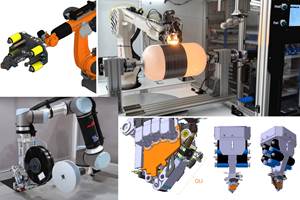Benteler SGL to supply composite leaf springs for new Volvo XC90
The rear axle of the new Volvo XC90 crossover SUV will use a composite leaf spring molded by Austria-based Benteler SGL using Henkel's Loctite MAX 2 polyurethane resin in RTM.
Henkel (Düsseldorf, Germany) reported on Dec. 11 that a fiber-reinforced composite leaf spring based on its polyurethane matrix resin Loctite MAX 2 is being used in the chassis of the new Volvo XC90, a crossover SUV of which the rear axle concept is to serve as a platform for other model series. Benteler SGL Composite Technology GmbH (Ried im Innkreis, Austria), a manufacturer of composite components for automotive applications, expects to produce several hundred thousand of these leaf springs per year.
In its alliance with Benteler SGL, aligned to the development and large-scale production of a composite leaf spring for Volvo Cars, Henkel has contributed in particular its process know-how in relation to RTM (resin transfer molding) so as to further optimize the cycle times that occur in the manufacture of fiber-reinforced components. Because of its low viscosity, the polyurethane matrix resin Loctite MAX 2 from Henkel rapidly fills the mold and quickly impregnates the fiber, resulting in short injection times. With the curing rate also substantially faster than that of epoxy resins, cycle times are shorter overall. Loctite MAX 2 has been successfully used in the mass production of leaf springs since 2013. In addition, the current project uses selected additives that make the curing process faster and more flexible.
“Within the development network comprising ourselves, BENTELER-SGL and Volvo Cars, the component manufactured with our polyurethane resin was subjected to extensive automotive-specific testing and validation,” says Frank Kerstan, global program manager automotive composites, Henkel Adhesive Technologies. “Applying our expertise in process optimization, we were able to demonstrate that this polyurethane technology could satisfy all the criteria of long service under environmental influences such as temperature and humidity.”
The leaf springs on new Volvo XC90 offer a highly compact design as well as weight savings of 4.5 kg compared to a conventional coil-spring concept. Further functional benefits arise from a smoother ride and improved NVH (noise, vibration, harshness) behavior. The trunk volume is also increased because there are no suspension turrets. Volvo operates on the basis of what is called Scalable Platform Architecture (SPA), according to which certain successfully implemented concepts are flexibly adapted for application to further vehicle models. The new rear axle is likewise destined to be incorporated into additional automobile models in the years to come, leading to several hundred thousand vehicles being fitted with it every year. The new Volvo XC90 is, therefore, just the beginning.
“The demands made in the automobile industry on the cost efficiency and reliability of production processes are huge,” says Frank Fetscher, head of business development at Benteler-SGL Automotive Composites. “The example of our leaf spring for Volvo Cars demonstrates that fiber composite mass production is today already a reality. What’s more, with this flexible component design, we are able to cover an entire platform with a relatively small number of spring variants. Having the right partner in Henkel, we have been able to build on our expertise, enabling us to further optimize the level of automation applied in our composite manufacturing operation. This current project shows that our lightweight leaf spring concept is suitable not just for commercial vehicles but also for passenger cars. We also feel Henkel’s polyurethane technology offers great potential for developing further automotive applications.”
Related Content
The next evolution in AFP
Automated fiber placement develops into more compact, flexible, modular and digitized systems with multi-material and process capabilities.
Read MoreA new era for ceramic matrix composites
CMC is expanding, with new fiber production in Europe, faster processes and higher temperature materials enabling applications for industry, hypersonics and New Space.
Read MorePlant tour: Spirit AeroSystems, Belfast, Northern Ireland, U.K.
Purpose-built facility employs resin transfer infusion (RTI) and assembly technology to manufacture today’s composite A220 wings, and prepares for future new programs and production ramp-ups.
Read MoreSulapac introduces Sulapac Flow 1.7 to replace PLA, ABS and PP in FDM, FGF
Available as filament and granules for extrusion, new wood composite matches properties yet is compostable, eliminates microplastics and reduces carbon footprint.
Read MoreRead Next
Plant tour: Daher Shap’in TechCenter and composites production plant, Saint-Aignan-de-Grandlieu, France
Co-located R&D and production advance OOA thermosets, thermoplastics, welding, recycling and digital technologies for faster processing and certification of lighter, more sustainable composites.
Read MoreVIDEO: High-volume processing for fiberglass components
Cannon Ergos, a company specializing in high-ton presses and equipment for composites fabrication and plastics processing, displayed automotive and industrial components at CAMX 2024.
Read More“Structured air” TPS safeguards composite structures
Powered by an 85% air/15% pure polyimide aerogel, Blueshift’s novel material system protects structures during transient thermal events from -200°C to beyond 2400°C for rockets, battery boxes and more.
Read More























